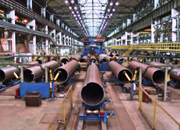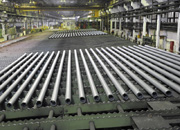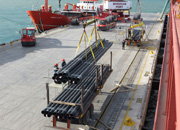S460C seamless steel pipe, as a high-strength low-alloy structural steel material, has wide applications in the industrial field. With its excellent mechanical properties, good weldability, and weather resistance, this steel pipe is an ideal choice for construction, machinery manufacturing, bridge engineering, and other fields.
Firstly, in terms of material properties, S460C belongs to the high-strength structural steel category of the European standard EN 10025-4, with a minimum yield strength of 460MPa. This steel achieves a perfect combination of high strength and good toughness by adding microalloying elements such as niobium, vanadium, and titanium, combined with controlled rolling and controlled cooling processes. Compared to ordinary carbon structural steel, S460C significantly improves strength indicators while maintaining good plasticity and toughness. This allows for thinner wall thicknesses in structural designs, resulting in weight reduction and cost savings. Furthermore, S460C also has good weldability, requiring relatively low preheating temperatures and eliminating the need for special post-weld heat treatment, greatly reducing construction difficulty and costs.
In terms of manufacturing processes, S460C seamless steel pipes are mainly produced using hot rolling or cold drawing processes. Hot rolling involves heating a steel billet to a high temperature, piercing it through a piercing mill to form a hollow tube blank, and then rolling it into a seamless steel pipe of the required specifications using a continuous rolling mill. This process is suitable for producing large-diameter, thick-walled pipes, offering high production efficiency and relatively low cost. Cold drawing, on the other hand, further processes the hot-rolled pipe at room temperature, using dies to draw the steel pipe to achieve higher dimensional accuracy and surface quality, while also improving the material's mechanical properties. Both processes have their advantages, and manufacturers will choose the appropriate process based on customer needs and product applications. It is worth noting that the production of S460C seamless steel pipes requires strict process control, especially temperature control and cooling rate control, which are crucial for the performance stability of the final product.
From an application perspective, S460C seamless steel pipes, due to their high strength characteristics, play an important role in many industrial sectors. In the construction industry, it is commonly used in the steel structural frames of high-rise buildings and the spatial grid structures of large stadiums, effectively reducing structural weight and improving seismic performance. In the construction machinery industry, S460C steel pipes are used to manufacture high-stress components such as crane booms and excavator booms. In bridge construction, this material can be used to create load-bearing components for long-span bridges, such as the arch ribs of arch bridges and the cable anchorage zones of cable-stayed bridges. Furthermore, S460C seamless steel pipes are widely used in energy equipment, shipbuilding, and pressure vessels. Especially in projects operating in extreme environments, such as high-altitude cold regions and offshore platforms, its excellent low-temperature toughness and corrosion resistance are particularly important.
When purchasing S460C seamless steel pipes, users need to focus on several key indicators. First, the chemical composition must meet standard requirements, as this is fundamental to ensuring material performance. Second, mechanical properties, including yield strength, tensile strength, elongation, and impact energy, directly affect product safety. Third, dimensional accuracy and surface quality are crucial, impacting the ease of subsequent processing and assembly. Furthermore, for steel pipes with special applications, additional technical requirements, such as non-destructive testing and hardness testing, are also necessary. Users are advised to choose reputable manufacturers and request complete quality certification documents.
From a technological development perspective, S460C seamless steel pipes will move towards higher performance and greater environmental friendliness in the future. On one hand, through composition optimization and process improvement, the strength-toughness balance of the material will continue to improve; on the other hand, more environmentally friendly production processes will be developed to reduce energy consumption and emissions. Furthermore, with the application of digital and intelligent technologies, quality control in steel pipe production will become more precise, and product consistency will be further improved. In application areas, with the advancement of national strategies such as new infrastructure and new energy, S460C seamless steel pipes are expected to find wider application in emerging fields such as wind turbine towers and photovoltaic supports.
In summary, S460C seamless steel pipes, as a high-performance structural material, play an indispensable role in modern industry. Its excellent performance characteristics, wide range of applications, and continuous technological advancements all indicate that this material has broad development prospects. For technical personnel and purchasing decision-makers in related industries, a thorough understanding of the characteristics and key application points of S460C seamless steel pipes will help to better leverage the material's advantages and create greater economic and social benefits.
 Threeway Steel is known as a professional supplier engaged in manufacturing and distributing a wide range of steel pipe, and our headquarter located the central part of China – Hunan and six associated factories throughout China.
Threeway Steel is known as a professional supplier engaged in manufacturing and distributing a wide range of steel pipe, and our headquarter located the central part of China – Hunan and six associated factories throughout China.
 Threeway Steel is known as a professional supplier engaged in designing, manufacturing and distribution of a wide range of steel products with the headquarter located the central part of China – Hunan and six associated factories throughout China.
Threeway Steel is known as a professional supplier engaged in designing, manufacturing and distribution of a wide range of steel products with the headquarter located the central part of China – Hunan and six associated factories throughout China.
 Threeway Steel is known as a professional supplier engaged in designing, manufacturing and distribution of a wide range of steel products with the headquarter located the central part of China – Hunan and six associated factories throughout China.
Threeway Steel is known as a professional supplier engaged in designing, manufacturing and distribution of a wide range of steel products with the headquarter located the central part of China – Hunan and six associated factories throughout China.
 Threeway Steel is known as a professional supplier engaged in designing, manufacturing and distribution of a wide range of steel products with the headquarter located the central part of China – Hunan and six associated factories throughout China.
Threeway Steel is known as a professional supplier engaged in designing, manufacturing and distribution of a wide range of steel products with the headquarter located the central part of China – Hunan and six associated factories throughout China.
 Threeway Steel is known as a professional supplier engaged in designing, manufacturing and distribution of a wide range of steel products with the headquarter located the central part of China – Hunan and six associated factories throughout China.
Threeway Steel is known as a professional supplier engaged in designing, manufacturing and distribution of a wide range of steel products with the headquarter located the central part of China – Hunan and six associated factories throughout China.

